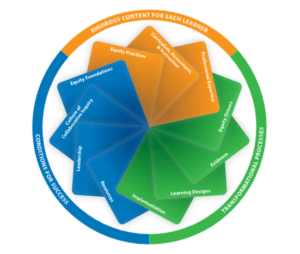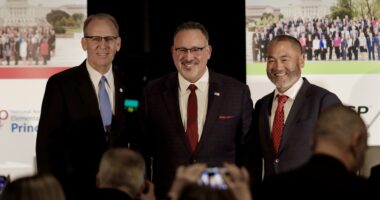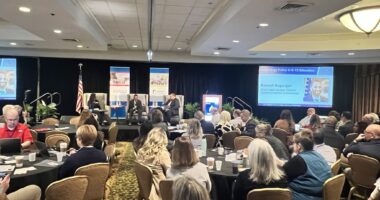A New Standard for Professional Learning
Revised Standards for Professional Learning ensure school leaders weave equity into every aspect of professional learning to improve educator practices and student results.

One of the favorite aspects of my job at the NAESP—associate executive director of Professional Learning—is having the opportunity to collaborate with other organizations representing the viewpoint of the elementary and middle-level principal. It is always an honor to serve in an advisory capacity, and this was especially the case when Learning Forward invited me to join in the work to revise their Standards of Professional Learning as a member of their Standards Advisory Council. The council, comprised of 27 other council members, met virtually over a two-year period to give input and support for the revision of the Learning Forward Standards of Professional Learning.
Framework for Professional Learning
 In late April, Learning Forward released the revised standards for professional learning that serve as a framework for educators who “plan, implement, and measure high-quality professional learning so they can achieve success with their systems, schools, and students.”
In late April, Learning Forward released the revised standards for professional learning that serve as a framework for educators who “plan, implement, and measure high-quality professional learning so they can achieve success with their systems, schools, and students.”
These 11 standards fit into three primary categories within the framework: Rigorous Content for Each Learner, Transformational Processes, and Conditions for Success. The purpose of creating this framework is to provide high-quality professional learning for educators that result in improved educator practices and improved student results where educators apply the 11 standards “in concert.”
- Rigorous Content for Each Learner: Standards contained within this frame describe the critical content of adult learning that leads to improved student outcomes: equity practices; curriculum, assessment, and instruction; and professional expertise.
- Transformational Processes: Standards within this frame describe process elements of professional learning that explain how educators learn in ways that maintain significant changes in their knowledge, skills, practices, and mindsets: equity drivers, evidence, learning designs, and implementation.
- Conditions for Success: Standards within this frame describe aspects of the professional learning context, structures, and cultures that support high-quality professional learning: equity foundations, culture of collaborative inquiry, leadership, and resources.
Examining the diagram more closely, one finds the interconnectivity among the standards and the nonlinear nature of the system. This means that there is no definite point of entry, and educators may delve into the Standards for Professional Learning at any point. The diagram also reflects the “cyclical, iterative nature of how professional learning leads to continuous improvement.”
Addressing a Need for Change
Equity in all aspects of school management—from students to the leadership team—is imperative for student success. One of the primary differences between the previous standards and the revised standards is how the framework has equity interwoven throughout each primary category. It was important to the Learning Forward staff as well as the Standards Advisory Council that equity did not stand alone, so we included it throughout the standards as equity practices, equity drives, and equity foundations.
There’s long been a focus on equity in schools, but the need is greater than ever. NAESP’s Leaders We Need Now research series looked at challenges of the 2020-2021 school year. It showed that the pandemic forced principals to put equity on the back burner over priorities like student and staff safety, navigating new demands as school leaders, and crisis management. These new standards are one way to ensure schools move equity back to the front burner as they make their way out of pandemic learning.
Uniting Education Leaders
Aside from the important work of revising the standards, I was in awe of the professional educators in the Zoom room. As I looked around my Brady Bunch square, I saw authors that I cited in my dissertation work—Joellen Killion, who serves as a senior advisor to Learning Forward, and Stephanie Hirsh, a former Learning Forward executive director. The council also featured members from award-winning school districts and international participants. I truly feel humbled and amazed to have been a part of this prestigious group—and to have been able to represent NAESP members and our mission along the way.
I cannot say that standards work is glamorous, but it is necessary. What would we be as school leaders without a standard to aspire to achieve? Professional standards, from the Professional Standards for Educational Leaders to these revised Learning Forward professional learning standards, inspire us to be the best that we can be as school leaders and staff developers. A huge portion of the work with the standards is making sure that the words used and language expressed accurately represents the standards. With many diverse opinions and constant wordsmithing, the process at times was tedious, but we knew we were a part of creating something necessary, important, and useful for educators in the field.
The Learning Forward team did an excellent job of keeping us all on track, providing opportunities for collaboration, and listening to our feedback. (Although too numerous to name all of the Learning Forward staff involved in the process, a special shout out goes out to the staff standards team: Denise Glyn Borders, Tracy Crow, Paul Fleming, Elizabeth Foster, and Machel Mills-Miles. Thank you for always being at every meeting and being so vested in the work of the advisory.)
The Standards for Professional Learning will support all educators in responding to the needs they face in schools every day through sustained and high-quality implementation. As school leaders, we face the challenge of dual roles: One is to make sure that we continue our own professional learning to expand our capacities as leaders, and the second is to facilitate and provide quality professional learning experiences for our school staff. At the heart of both is wanting to ensure that each student experiences the best possible teaching and learning for their continued success. Possessing a thorough understanding of current Standards for Professional Learning is the first step in establishing high-quality professional learning systems to achieve equity for all learners.
As you check out the revised Standards for Professional Learning, know that you’re not alone in navigating this changing world of education. NAESP is keeping these standards in the forefront of our planning as we develop resources and programs to help you succeed as an elementary or middle-level principal or assistant principal.
Gracie Branch is the associate executive director, Professional Learning, at NAESP.




